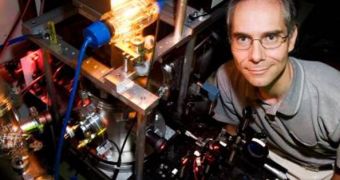Researchers at the University of Illinois in Urbana-Champaign (UI) have recently developed a new, simpler way of getting proteins to fold, a process that must be understood before complex studies into the nature of these tiny blocks of life can be conducted. Thus far, other methods relied on changing the temperature of the mix holding the proteins, which caused the tiny molecules to fold or unfold according to needs. However, a UI specialist believes that pressure may be a better way to go about forcing a protein to fold.
Expert Martin Gruebele, who is the James R. Eiszner Professor of Chemistry at the university, noticed that by relieving the pressure of the mix, for a tiny fraction of a second, folding was encouraged, and the damage sustained by the protein itself was about 100 times smaller than that it got after temperature shifts. He says that “pressure jumping” is a much “kindler, gentler way” to induce folding.
“When you're increasing the pressure on something, you're squeezing the atoms and making them come closer to one another, but you're not necessarily causing the very complicated changes to the microscopic motion that occur when you change the temperature. Pressure is a simpler variable than temperature,” the expert explains.
“Temperature is a pretty complicated variable in that it involves random motion at a microscopic level. When you perturb a protein by raising its temperature, its chains completely unravel, and it might take longer for it to collapse back down to the folded structure,” Gruebele adds.
According to the scientist, pressuring a protein at more than 2,500 atmospheres, which would be enough to compact us into a tiny trace of our former selves, is actually less disruptive than heating or cooling the sample down by as little as 30 degrees. “By putting experiments and computer simulations together, we're going to be able to predict how proteins fold much more quickly and reliably,” he says.
“The structures of proteins are ultimately what's responsible for their function. Changes to their structure often cause abnormal functions. That's why we want to understand protein structures, and be able to model how they change. There are only a handful of proteins that we know about that would fold by temperature jumps or other methods in a couple of microseconds. But there are many proteins that do it in hundreds of microseconds, and that could be sped up to a few microseconds by pressure jumps,” the researcher concludes.

 14 DAY TRIAL //
14 DAY TRIAL //